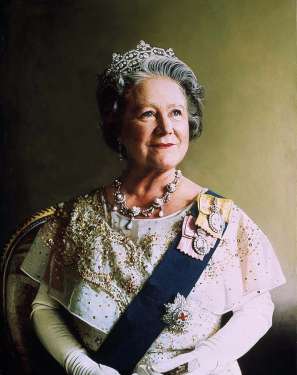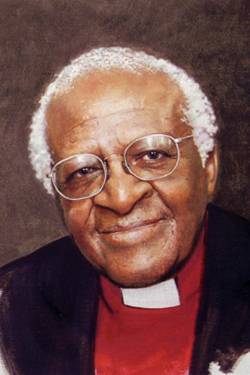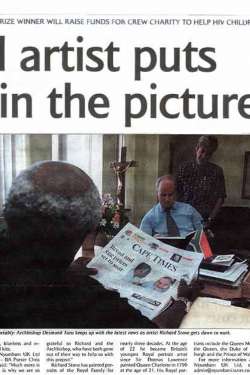“I phoned the Queen Mother and asked”
The Daily Telegraph, p.13 August 2002

Her Majesty Queen Elizabeth, The Queen MotherRichard Stone is Britain's most prolific Royal portrait artist. Karen Gooch reveals how he overcame deafness to fulfil his dream
The man striding towards me in the school car park looks like a typical City father on the school run, dressed in razor-sharp pinstripes, quirky tie (covered with zebras) and sporting a yellow silk handkerchief in his top pocket.
The man striding towards me in the school car park looks like a typical City father on the school run, dressed in razor-sharp pinstripes, quirky tie (covered with zebras) and sporting a yellow silk handkerchief in his top pocket.
But Richard Stone is more likely to head in the direction of Buckingham Palace, Kensington Palace, or, if the Queen Mother were alive, Clarence House, than to the Stock Exchange. Although his profile remains fairly low, he is the country's most prolific Royal portrait artist, who this year celebrates his own jubilee - 30 years of capturing the likenesses on canvas of almost every senior Royal.
He is also the only artist whose Royal subjects span four generations, from the Queen Mother, the Queen, the Duke of Edinburgh and their four children, to the younger generation, including Princes William and Harry.
With grey hair combed to perfection and black shoes buffed to a glassy shine, Stone does not look like an artist. And his perfectly enunciated vowels conceal his roots as the son of an Essex postman who started life in a semi in Colchester.
When he walked into Clarence House 30 years ago, dressed in a suit and tie, for his first Royal commission to paint the Queen Mother, she asked him, in puzzled tones: "Don't you have a smock?" "I told her there was no need - I was a very clean painter," he says. "She let me use the Garden Room for sittings, and must have been relieved that I didn't leave any paint splashes on the floor."
Stone's mother had instilled in him the importance of always being well-groomed, polite, and of thinking twice before speaking - all characteristics that have enabled him to fit into Royal households.
The Queen Mother and her courtiers were surprised by his formal attire, he says, but it helped him to blend in - and she invited him to stay for lunch after her third sitting. Most other artists were usually asked to lunch only after the final sitting, if at all.
Many years before, at the age of four, Stone had stood at the railings of Buckingham Palace with his parents and precociously announced: "I'm going to paint the Queen." But a near-fatal accident later that year nearly shattered the ambition - on Boxing Day, he tripped over his slippers, tumbling down the stairs of the family home, and ended up in a coma for several weeks with a fractured skull. His parents were warned to expect brain damage, but when he regained consciousness, it was discovered that he was deaf.
"I was deaf in one ear and had severely impaired hearing in my left ear," he recalls. "At night, I would scream because of the strange noises in my head. To some extent, I was forced to live in a bubble and, at school, I became the class comedian because I would make inappropriate replies to anything said to me. "I wasn't hideously unhappy, but I was at my happiest just drawing. It was my escape. I drew everything around me: the view from the window, objects - but not people. I tended to shy away from them."
Soon, this serious little boy was getting noticed by his teachers. "They couldn't do much with me, because of my deafness, so they gave me crayons. Seeing that I could draw, they entered me in competitions. I started winning - £5, which was a lot in those days, or a box of paints - all sorts of things. "No one else in the family was interested in art. My brother always laughed and said that there must have been a mix-up in the maternity home." The only image of royalty in the house was a photograph of the young Queen Elizabeth II on a biscuit tin.
Stone's hearing gradually improved, and on 14th birthday, his neighbour took him to the Royal Academy's annual show, where he saw the work of Sir Gerald Kelly, who had painted the state portrait of George VI and Queen Elizabeth. Stone was mesmerised and promptly wrote a "cringe-making, embarrassing" fan letter to Sir Gerald, telling him he thought he was the greatest thing since Rembrandt. "I said that I, too, wanted to be a portrait painter and asked him to give me some tips."
Kelly replied, asking Stone to bring as much of his work as possible to Kelly's studio in Gloucester Place, but adding, severely: "I will do my best to dissuade you from embarking on such a course." Stone wasn't to be discouraged and, over several meetings, Kelly regaled him with stories of his time in Paris at the turn of the last century, working for Monet, and of how he would tie paintbrushes to the arthritic wrists of the ageing Renoir.
After completing his A-levels, Stone was devastated when his application to Colchester School of Art was rejected. "I was never told why," he says. The Royal Academy and the Slade also turned him away, without even an interview. "I don't feel bitter about it," he says, not wholly convincingly. "It made me all the more determined."
Not long before Kelly died, in 1972, he telephoned Stone's worried parents, reassuring them that their son had the talent to succeed. Then, he told Stone to "go out there and knock on doors". Remembering how Kelly had described the Queen Mother as being the "perfect artist's sitter", Stone telephoned Clarence House, asking if he could paint Her Majesty.
"Eventually, I was put through to Lord Adam Gordon, the comptroller of her household, who must have wondered who on earth this pushy young man was. He told me politely, but crisply, 'Thank you, but you cannot expect Queen Elizabeth to sit for any Tom, Dick or Harry who phones'." Stone quickly retorted: "Oh, but please don't dismiss me - I could be a latter-day Rembrandt."
Finally, Gordon invited him to show him his work, and then commissioned him to draw his wife. Stone's efforts passed muster, and Gordon advised him that if he wanted to paint the Queen Mother, he would need to get himself an official commission. He hinted that the Royal Anglian Regiment, of which the Queen Mother was honorary colonel-in-chief, wanted to mark its 10th anniversary in some way.
Stone seized the opportunity, phoned the regiment, and won the commission. It made him the youngest Royal portrait painter since Sir Thomas Lawrence painted Queen Charlotte, wife of King George III, in 1790. "She was absolutely wonderful," Stone says. "Warm, witty and kind. On hearing about my trouble getting a mortgage - being self-employed - she insisted I let her buy two of my studies of her. It was very generous, and helped me to buy my first cottage." Stone, now 50, lives in a more elegant, Georgian house in the same area of Colchester with his second wife, Rhonda, and their eight-year-old son, William.
His next royal commission was a portrait of Princess Margaret - also on behalf of the Royal Anglian Regiment - during the summer of 1981, three years after her divorce from Lord Snowdon and during her relationship with Roddy Llewellyn.
Sometimes, the Princess would fail to appear for sittings in her apartment at Kensington Palace. "I would be told by a courtier, after waiting for a while, that she wouldn't be available that day," Stone says. "With hindsight, it was obviously a very sad time in her life." When she did appear, she wanted to see the progress made each time. On one occasion, after scrutinising a pencil study, the Princess said, firmly: "I hope you will destroy that, Mr Stone." She complained that he had made her look tired.
"I was a little sad that she was so harsh about it and I didn't destroy it," he says. The study now hangs on his studio wall. Midway through the sittings, the Princess went on holiday with Llewellyn, and came back, according to Stone, looking much better - tanned and beautiful.
"I asked her if she had had a nice holiday, and she replied that it was the worst holiday imaginable. I didn't like to probe further, and assumed the weather must have been awful. I later read that it was during the holiday that Roddy Llewellyn had told her that he wanted to marry someone else."
Stone eventually produced the radiant image the Princess wanted, yet she had probably never been more miserable. However, she was generous enough to suggest to Prince Charles that Stone be given the first commission to paint his then fiancee, Lady Diana Spencer. But the commission went to Bryan Organ, and it is one of Stone's biggest regrets that he never got the chance to paint Diana.
However, two years ago, he completed a portrait of the Prince of Wales, which he donated to the Gordon Highlanders Museum in Aberdeen. The portrait caused a small stir when it was discovered that Stone had painted the regiment's tie wrongly knotted, and he had to paint out the yellow band at the top. Stone took responsibility for the faux pas, but tells me that, in fact, the tie had been given to him to paint on after the Prince's sittings - ready-knotted.
The Prince of Wales could spare Stone just two sittings for the portrait, which took place in "a stone, reception-type centre in the grounds of Highgrove. It was far from ideal and we were sitting, knees nearly touching, with the easel between us."
Did the Prince engage in small-talk? "Yes, he was very friendly and, at one point, recommended a book on education while we were talking about schooling for our children. But the light was especially poor. I don't know why, but I consistently get bad weather when I paint the Royal Family.
"With the Queen, I was so concerned about the light that I brought in some lighting equipment because I knew it would be inconsistent otherwise, and I needed the effect to be quite dramatic." The portrait was finished in 1991, after nine sittings over three years. It came about, yet again, as a result of Stone's opportunism. Hearing that Colchester was to celebrate its 800th anniversary of the granting of its royal charter, he asked if he could produce a portrait of the Queen which could be donated to the town.
It now hangs in the town hall. Its reception was dramatic, with one tabloid greeting it with the headline: "Royal Wrinkly Rumpus." Stone defends painting lines on the face of the monarch, who was then in her sixties.
"It would have been absurd to have done otherwise," he says. The Queen was equally unperturbed. On leaving the yellow drawing room at Buckingham Palace, after the final sitting, she quipped: "It will make a good stamp." Other portraits have not been so well received by the Queen. She confided in Stone, during one sitting: "One would wish to consign some of them to the basement."
Even Stone's favourite Royal sitter, the Queen Mother, could be demanding - though in her own inimitably charming way. During sittings for his first portrait of her, he recalls her asking: "Do you mind taking a little off the waist?" With her finger hesitating over the waistline, Stone replied: "I'll paint away, Ma'am; you just tell me when to stop." The moment she had left, however, he expanded her waist to its original girth.
"She'd wanted an almost wasp waist, which would have looked ridiculous," he says. Didn't she notice the difference at the next sitting? "She didn't make any comment when she saw the final result, but she knew." She didn't take offence - Stone went on to paint her on three other occasions.
In between his commissions of the past two years, which have included portraits of Baroness Thatcher and Archbishop Desmond Tutu, Stone has embarked on a mammoth project - a 7ft-by-10ft portrait of the Earl and Countess of Wessex at their wedding in St George's Chapel, Windsor.
It is the first commission for a Royal wedding in more than a century, and will be a companion piece to William Frith's painting of the wedding of the future Edward VII to the Danish Princess Alexandra. It is identical in size to the Frith, and will include the 100 guests.
Stone couldn't resist the challenge after the Duke of Edinburgh, walking Stone down the Grand Corridor at Buckingham Palace, pointed out the Frith and remarked: "Do artists paint pictures like this any more?" "Yes, if they are given the opportunity," replied Stone.
So why does he think he has been given so many Royal commissions?
"I'm terribly easy-going," he says. "I chat about everyday things. But if I sense they want to be quiet, then I leave well alone. I've never broken a confidence, and they know they can trust me."





